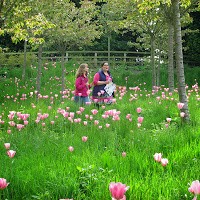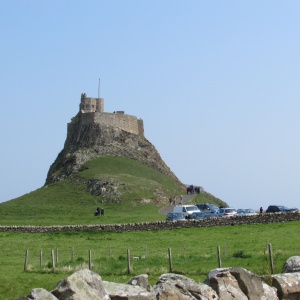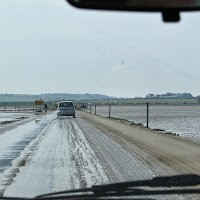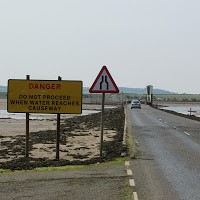Lindisfarne
Lindisfarne is a causeway island, meaning that when the tide is in, it is completely inaccessible from the mainland. We checked the tide charts twice, to be sure we would have time to visit and get off the island (Anna’s father said about one vehicle a year gets stuck on the causeway at high tide, and Wikipedia says one per month!), then made our way across the causeway at about 10:30.
Although this was thirty minutes into the safe crossing time, the road was still badly flooded, and we had to proceed with some care. Anna’s little Ford KA (which she adorably calls “Ka”), made the crossing without any problems, despite my Dad joking repeatedly that we were going to break down and have to follow the old pilgrim’s walk. We parked in visitor parking and made our way to the priory.
Lindisfarne Priory
Lindisfarne priory is (according to English Heritage) best known as the home of St. Cuthbert, the patron saint of Northumbria. It was founded in the sixth century by St. Aiden of Iona, but the place is (to a student of history, at least) best known as the home of The Venerable Bede. St. Bede was a monk at the priory in the eighth century, who wrote The Ecclesiastical History of Britain.
The Lindisfarne Gospels—an illuminated manuscript containing the gospels of Matthew, Mark, Luke, and John—were created at the priory, and were on exhibit at a nearby museum, but the time limit imposed by the incoming tide prevented us from seeing them.
We wandered the remains of the priory for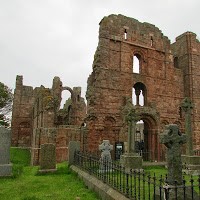 some time, reading the various plaques and scrambling (where permitted) among the tumbled rock. We found the large, now illegible tombstones of several monks, and a modern bronze statue of St. Cuthbert—labelled in braille at its base. St. Cuthbert, it seems, chose Lindisfarne for its remoteness, but would, on occasion, journey to another nearby island to meditate in total solitude.
some time, reading the various plaques and scrambling (where permitted) among the tumbled rock. We found the large, now illegible tombstones of several monks, and a modern bronze statue of St. Cuthbert—labelled in braille at its base. St. Cuthbert, it seems, chose Lindisfarne for its remoteness, but would, on occasion, journey to another nearby island to meditate in total solitude.
Lindisfarne Castle
When we had finished at the priory, we made our way to the headland of the island, where the National Trust maintains Lindisfarne Castle. This was originally constructed as a Tudor fort, and later converted to a private home. The path up to the castle is very steep, with steps occasionally cut into it to make the ascent easier. I was especially grateful for the rope handrail, since the stone path was very slippery.
Our time on the island was running short, so after a quick visit to the castle battery, with a spectacular view across to Bamburgh castle on the mainland, we headed back to the parking lot (with a quick detour to the gift shop so Anna could pick up some Lindisfarne mead; Holy Island is famous for this drink, and for good reason—it’s delicious!) We paused on our way across the causeway and stepped out of the car so I could get a sense of how barren the space was. Streamers of seaweed and large tracks of sand and mud were strewn across the tarmac road, but I couldn’t hear the sea at all! A number of platforms have been built at various points along the causeway for stranded visitors to retreat to if they aren’t smart enough to turn back at the “Do not proceed when water reaches causeway” signs. 😉
Alnwick Gardens
